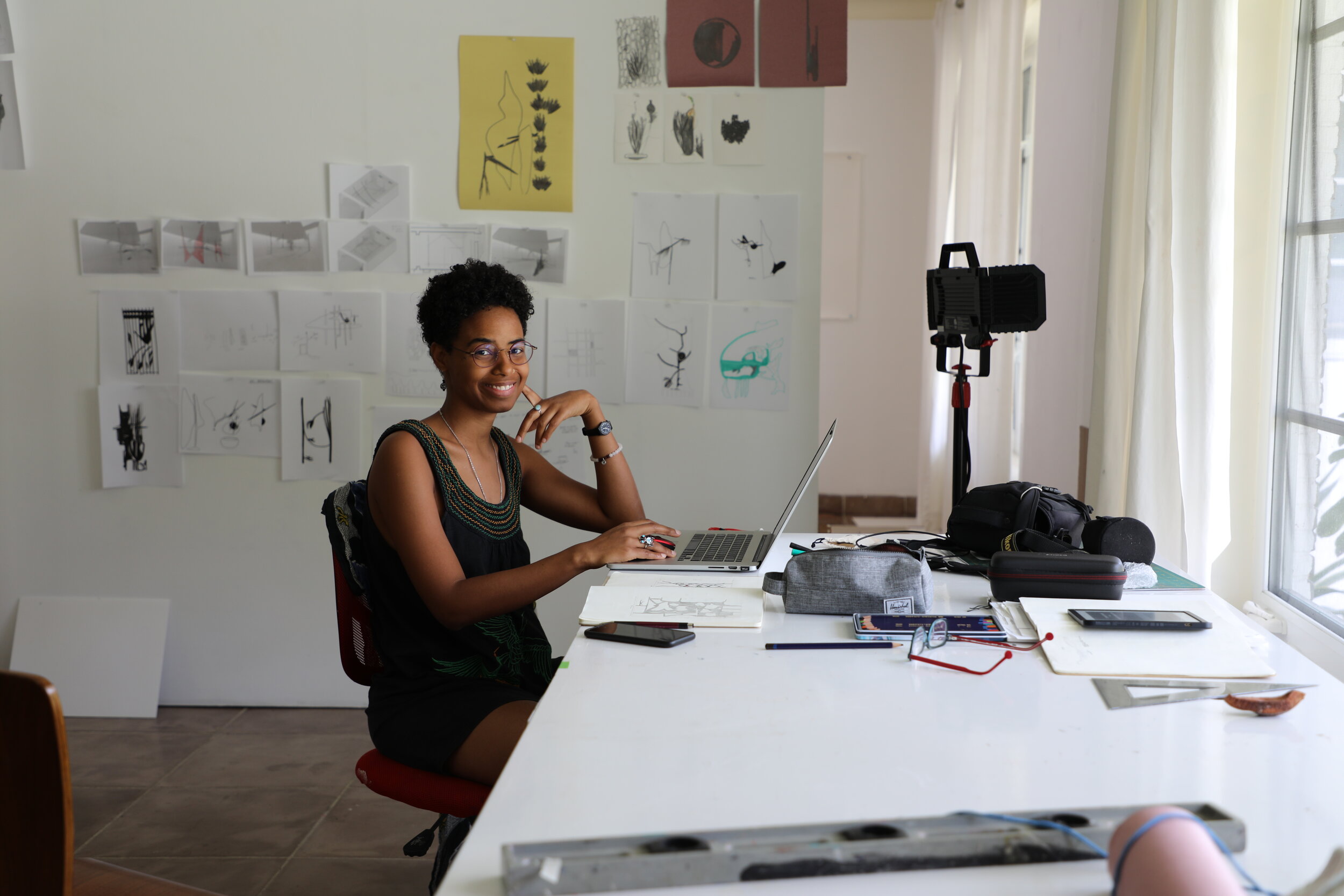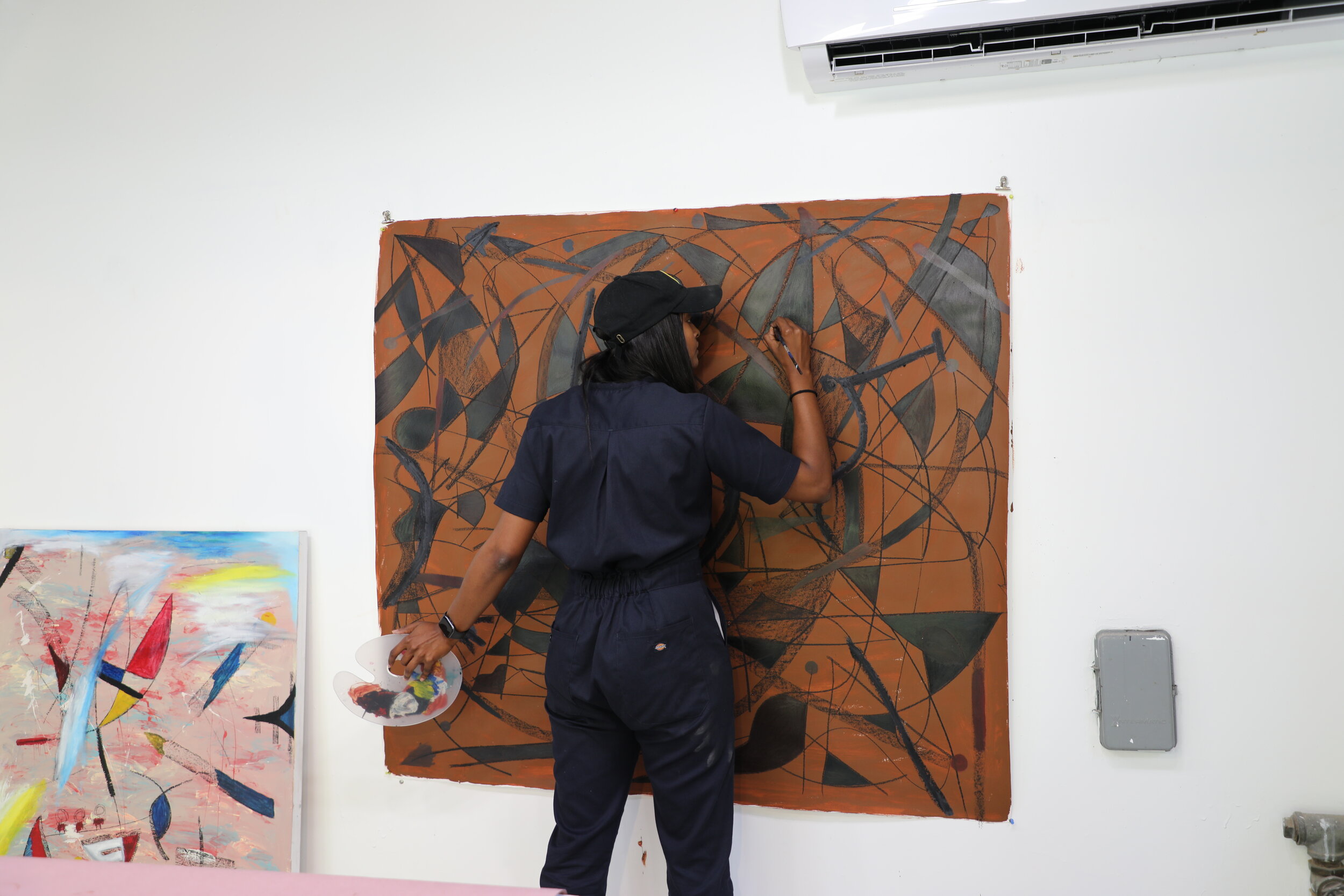April 2021
For a young artist, there are moments that stand out as being particularly formative - whether that’s a spark that sends their practice in a new direction, or an opportunity that sets their trajectory soaring. Fountainhead often offers a little bit of both: Working in community with one another in an unfamiliar city often leads to new explorations; while a vigorous pace of studio visits with curators, collectors, and gallerists tends to boost the artist’s access to new realms of possibility.
April’s artists-in-residence certainly experimented with both. Minia Biabiany, Muna Malik and Fatma Shanan hail from different corners of the globe, with Muna living in Los Angeles by way of Yemen; Minia splitting her time between her native Guadeloupe and Mexico City; and Fatma hailing from a Druze village in Israel. While each of their practices venture into the autobiographical, they do so quite differently - each responds to their immediate surroundings but diverge in medium and method of entry. Their experience together, says Minia, was enriched because of the intimacy the residency provided.
“I’ve done four artist residencies before this one, and the shared living space at Fountainhead made the human relationship between us very rich,” she says. “We don’t have the same approaches in our work so it was interesting to be immersed in that - it was a sweet month of discovering their practices.”
Fatma agreed that a departure from an otherwise solitary practice pulled her toward a new direction, as she decided to focus more on drawings during her time in residence. The spontaneity of looking at and offering feedback on each other’s work was both intuitive and fruitful. “I think it’s great that the studios are all in the same space for that very reason,” she says. “There’s a duality between relationships, the artwork and your personal life.”
And for Muna, an artist who is still acquainting herself with an artistic career, the experience was nothing short of transformative. “Fountainhead gave me the opportunity to finally meet with a collection of curators, collectors and institution heads. It's not too often that you get the opportunity to meet such a wide range of people in the art world, all within a span of a few weeks,” she says. “This residency completely changed my life because it's created an entire network of people that I would have aspired to be able to meet.”
Minia Biabiany
Minia works primarily with film and installation to interrogate the colonialist history of Guadeloupe. She uses objects in her work, believing that the historical charge of her materials tells a powerful story about the hierarchical framework that persists on the island. She’s intrigued by how French domination has seeped into the everyday vernacular of its inhabitants, creating a structure for storytelling that’s distinctly unique to its identity. What’s most interesting to Minia is that this framework is unspoken, and exists subtly within the tension of its dueling languages, Creole and French. Language plays an important role in Minia’s work, who believes that poetry within visual art offers the possibility to communicate deeply.
“When I make my work, I think about whether I can invent a language to talk about the silence that exists around Guadeloupe’s complex relationship to France,” she says.
There are several themes that reoccur in her works, which are generally immersive and often transportive. Weaving, as both a literal act and figurative method of storytelling, emerges frequently, with fishing traps, threads, and dialogues being layered onto one another in both film and installation. Banana leaves, conch shells, and carved wooden pieces tell stories about labor, rebellion and escape. Minia’s works are never a direct confrontation with their material, but rather a slow and gentle song for the viewer to unravel.
At Fountainhead, Minia prepared for an upcoming film commission with the ICA Miami and researched ideas around her next projects for the Future Generation Art Prize in Kiev and the prize Ricard in Paris.
Muna Malik
Muna Malik’s abstract and sculptural works allow her to parse through identity as both spectator and participant. Culling shapes, colors, and textiles from the rich traditions of her Somali and Yemeni heritage, Muna distorts the American perception of east African culture, which is generally formed through images of war and conflict. Because her practice is primarily meditative - Muna often paints to the frenetic rhythms of jazz music - she is also able to break down some questions of her own: Muna emigrated to the United States from Yemen when she was young, and grew up in Minnesota, which created a lot of complexity around who she was in this new world.
“Suddenly, I had to understand what it meant to be Black in America as an immigrant who didn’t have the same language and culture,” she says. “A lot of my work addresses identity and what happens when you step out of your environmental context.”
Movement is the impetus behind Muna’s abstract paintings, as she focuses on gestural markings to remain free in the creative process, or otherwise “free from the external pressures of how she is viewed in society,” she says. Muna sometimes works with Somali or African fabrics and textiles instead of canvas, and usually selects primary colors and geometries that stem from Yemeni and Somali gateways, mosaics, and clothing. The paintings she created at Fountainhead displayed a Mehretu-esque gift for capturing energy on canvas, but Muna also creates photographic collages and sculpture as modes through which she can disentangle complexities around race and xenophobia.
“Abstraction, like identity, is amorphous: What I see may not be what you see,” she says. “My relationship with abstract art is ever-changing, just like identity.”
Fountainhead was Muna’s first major residency, and she used the opportunity to showcase her work and the context from which she creates it. The experience allowed her to connect with curators, collectors, and artists who enriched the experience with new ideas.
Fatma Shanan
Fatma Shanan is on an identity quest of her own. According to her, growing up within a Druze community in Israel has stifled her individual expression, and she’s interested in understanding how place shapes the experience of connecting with your truest self. Her work is a balancing act between the individual and the collective, as Fatma creates self portraits that find her embedded within natural landscapes, as though she is one with the natural world. Transcending from mere observer to a part of the ecosystem allows her a certain freedom, both personal and artistic. In Miami, she was interested in expressing the relationship between herself and the nature she encountered in the city.
Much of her recent work is inspired by the writings of Walt Whitman, who framed a historical dialogue around the human experience within nature. Whitman’s writings make up the basis of an American mystique around nature and freedom - one that Fatma is interested in dissecting through her work. Turning her hair into flowers, her limbs into branches or submerging herself in water among schools of fish, Fatma harnesses her own body to connect more deeply with place and identity.
“In my practice, I’m most interested in how I am affected by my immediate environment and how my presence also affects that territory,” she says.
Fatma paints from staged scenes she photographs before initiating a painting. Sketching is also an integral exercise within her work, though her drawings rarely become paintings. Instead, Fatma draws to meditate on how she might take her work in different, perhaps more surrealist directions.
At Fountainhead, Fatma experienced Miami’s natural environment and explored how it might inform her future works. Much of her time was spent free diving in the ocean, which she anticipates will soon appear as an important theme in her work.














































